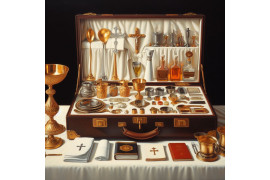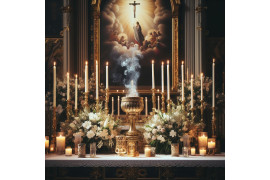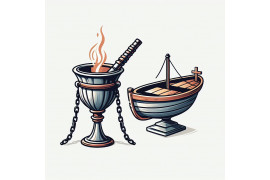Monstrances, the sacred vessels used in Catholic worship, play a vital role in displaying the consecrated Eucharist during adoration, holy communion, and processions. They are used to showcase the blessed sacrament, which is kept in the tabernacle. These ornate vessels, often made of gold, such as the ciborium used in holy communion, serve as a focal point for believers to visually connect with the presence of Christ in the tabernacle. These church supplies are essential for religious ceremonies. By symbolizing reverence and devotion towards the Eucharist through Eucharistic adoration, monstrances enhance the spiritual experience for worshipers of the blessed sacrament and holy communion. The consecrated hosts are displayed for all to see and adore.
The choice of gold for monstrances is not arbitrary but holds significant meaning in the context of the tabernacle and the consecrated hosts, also known as sacred hosts or the blessed sacrament. The use of this precious metal highlights the importance and value attributed to the blessed sacrament and Eucharistic adoration, especially in the presence of the tabernacle during private adoration. The shimmering gold surface reflects both the physical beauty and spiritual significance of the Eucharist during Eucharistic adoration. The blessed sacrament, represented by the consecrated hosts, is kept in the tabernacle. Through their intricate designs and craftsmanship, these golden vessels evoke a sense of awe and reverence among believers in the church. The tabernacle, containing the consecrated hosts, holds the blessed sacrament.
Join us as we uncover the symbolism behind these magnificent church supplies, such as the tabernacle, that enrich our worship experience. Explore the blessed sacrament and the Eucharistic adoration that is centered around the consecrated hosts.
Historical and Cultural Reasons for Gold Use in Monstrance Construction
Throughout history, gold has held a special place in various cultures, symbolizing divinity, royalty, and wealth. In the church, gold is used to adorn sacred objects such as the tabernacle and the sacred host. It is a symbol of reverence and devotion. Additionally, gold is often used in religious art to depict heavenly glory. The significance of gold in religious contexts cannot be understated. It is no wonder that gold is often used in the construction of monstrances, reflecting its symbolic value as a precious metal representing purity and holiness in the tabernacle. The blessed sacrament, during Eucharistic adoration, is typically held in a vessel such as a monstrance.
The cultural significance attached to gold makes it an ideal choice for crafting majestic monstrances that hold the blessed sacrament in the tabernacle, preserving it for hours in a sacred vessel. The historical association of the tabernacle with divinity adds to the sacredness of these blessed sacrament vessels. The use of gold in monstrance construction, especially for the blessed sacrament, has been prevalent for centuries and remains popular today. The hour of adoration is enhanced by the beauty of the gold used in these sacred vessels.
One of the primary reasons for using gold in monstrances is its durability when displaying the blessed sacrament. Gold is known for its resistance to corrosion and tarnish, making it a suitable material for long-lasting religious objects such as the blessed sacrament. Monstrances, used to display the blessed sacrament, are often prominently featured during religious ceremonies and processions. Therefore, it is crucial that these sacred vessels withstand the test of time.
Another reason for choosing gold is its timeless appeal. Gold, a precious metal treasured by us throughout history for its beauty and rarity, is like a sacrament. The warm hue of the monstrance exudes elegance and grandeur, captivating us with its visual impact. The use of gold enhances the overall aesthetic value of the religious artifact, capturing attention and inspiring reverence among worshipers.
Moreover, gold's association with wealth aligns with the idea that offering one's best to God demonstrates devotion and respect to us. By using such a precious material in the construction of monstrances, churches convey their commitment to honoring God through opulent displays.
In addition to these historical and cultural reasons, there are practical considerations behind using gold in monstrance construction. Gold is a malleable metal that can be shaped into intricate designs without losing its structural integrity. This allows artisans to create elaborate details on the surface of the monstrance, further enhancing its beauty.
Furthermore, gold possesses excellent reflective properties that enhance the display of the consecrated Host within the monstrance. When light shines upon it, the gold surface illuminates, drawing attention to the sacred presence of the Eucharist. This visual effect adds to the spiritual experience of worshipers and emphasizes the significance of the Host.
Importance of the Eucharist: Body and Blood of Jesus Christ
According to Catholic belief, during Mass, bread and wine are transformed into the actual body and blood of Jesus Christ through transubstantiation. This profound transformation is at the heart of the Eucharist, which holds immense significance in Catholic worship.
The Eucharist is considered central to Catholic worship, as it represents Christ's sacrifice on the cross for humanity's salvation. It serves as a commemoration of the Last Supper, where Jesus shared bread and wine with his disciples before his crucifixion. By partaking in Holy Communion, Catholics believe they are participating in this sacred feast and receiving Christ himself.
Catholics hold a deep reverence for the Eucharist because they believe that receiving it brings them closer to God's grace and strengthens their faith. The act of consuming the consecrated host is seen as an intimate union with Jesus, nourishing both body and soul. It is a moment of spiritual communion that allows believers to experience the real presence of Christ within them.
To emphasize the importance of this sacred element within Catholic theology, the monstrance serves as a vessel that showcases the consecrated host during Eucharistic processions and Eucharistic adoration. The monstrance is typically made from precious materials such as gold or silver, symbolizing its significance and honoring its contents.
The use of gold in constructing a monstrance has several symbolic meanings. Gold is associated with royalty, divinity, and purity. It represents the preciousness of Christ's body and blood contained within the Eucharist. Gold reflects light beautifully, signifying how Christ illuminates our lives with his presence.
During Eucharistic processions or Eucharistic adoration, where Catholics gather to pray before the exposed Blessed Sacrament in a monstrance, this golden vessel becomes a focal point for devotion and reverence. It draws attention to the real presence of Christ and invites believers to deepen their faith through prayer and contemplation.
The Pope, as the leader of the Catholic Church, often carries a monstrance during special liturgical celebrations. This further emphasizes its significance and underscores the importance of the Eucharist in Catholic worship.
Varied Styles and Designs of Gold Monstrances
Gold monstrances are not just ordinary vessels; they are intricately designed works of art that hold great significance in the Catholic Church. These sacred objects come in a wide array of styles, ranging from traditional Gothic designs to more contemporary interpretations. Let's explore the diverse world of gold monstrances and discover why they are so special.
Unique Artistic Traditions
Different regions around the world have developed their own artistic traditions. This has resulted in distinct variations in design, making each one truly unique. For example, during the Middle Ages, Gothic-style monstrances with pointed arches and intricate details were prevalent in Europe. In contrast, Latin American countries often feature baroque-style designs with rich ornamentation and vibrant colors.
Elaborate Engravings and Intricate Filigree Work
One of the defining features of gold monstrances is the elaborate engravings and intricate filigree work that adorn them. Skilled artisans painstakingly carve intricate patterns onto the surface of these golden vessels, creating beautiful designs that catch the light and draw attention to the sacred host within. These engravings can range from delicate floral motifs to scenes depicting biblical stories or saints.
Gemstone Embellishments and Statuesque Figures
To further enhance their beauty, gold monstrances may also be embellished with gemstones or adorned with statuesque figures. Precious stones such as rubies, emeralds, or sapphires are often used to add a touch of opulence to these already magnificent pieces. Statuesque figures made from materials like ivory or wood may be incorporated into the design, representing important religious figures or symbols.
Personal Expression and Cultural Preference
The variety in styles and designs allows for personal expression and cultural preference to be expressed through the choice of a monstrance. A priest or bishop may select a specific style that resonates with their personal taste or reflects the traditions of their region. For example, in an adoration chapel dedicated to a particular saint, a monstrance featuring symbols associated with that saint may be chosen.
Symbolism and Reverence
Gold monstrances hold great symbolism and are treated with utmost reverence during religious ceremonies. The golden color represents the glory and divinity of Christ, while the rays emanating from the host symbolize His presence illuminating the world. The intricate designs and precious materials used in these vessels serve as a visual reminder of the sacredness of the Eucharist.
Exploring the Intricate Details of Gold Monstrances with Luna
Luna, the circular receptacle within the monstrance, plays a crucial role in holding the consecrated host securely. It is not just any ordinary piece; it is often crafted from precious metals like gold and adorned with intricate patterns or gemstones, further enhancing its beauty.
One of the primary purposes of Luna's design is to ensure that the Eucharist remains visible while being protected within the monstrance. Craftsmen pay meticulous attention to detail when creating these delicate components of gold monstrances. They understand that this treasure holds immense significance for private adoration and public display during religious ceremonies.
The choice of using gold for Luna is not arbitrary but deeply symbolic. Gold has long been associated with divinity and purity throughout history. Its radiant glow mirrors the divine presence within the Eucharist itself. The golden luna reflects both reverence and awe towards the Lord.
The craftsmanship involved in creating a gold luna is truly remarkable. Skilled artisans employ various techniques to shape and mold this precious metal into intricate designs that captivate onlookers' attention. From delicate filigree work to elaborate engravings, each luna becomes a unique masterpiece.
In addition to its aesthetic appeal, there are practical reasons for using gold as well. Gold's malleability allows craftsmen to fashion it into intricate shapes without compromising its structural integrity. This ensures that the luna can securely hold and display the consecrated host during Mass or private adoration.
Moreover, gold's durability ensures that these pieces can withstand regular handling and use without losing their beauty or functionality over time. This longevity makes them ideal for passing down through generations as cherished heirlooms within religious communities.
The presence of glass in some lunas adds another layer of symbolism and functionality. The transparent material allows sunlight to pass through, creating a stunning interplay between light and gold. When the sun's rays hit the luna, it creates a radiant sunburst effect, symbolizing the divine presence within.
Crafting a gold luna involves several intricate steps. Artisans begin by melting down the gold and carefully pouring it into molds to create the desired shape. Then, they meticulously work on refining and polishing the piece to achieve a flawless finish. Gemstones or other embellishments are added as a final touch to enhance its beauty further.
It is important to note that creating these exquisite pieces requires time, skill, and expertise. Craftsmen invest hours of labor into each luna, ensuring that every detail is perfect before it reaches its final form. This dedication ensures that these sacred items can be treasured and revered for years to come.
Liturgical Context and Purpose of Monstrances in Worship
Monstrances are an integral part of worship in the Catholic Church, serving a significant role in various liturgical practices. These ornate vessels are primarily used during Eucharistic adoration, where believers gather to pray and worship before the exposed Eucharist.
During Eucharistic adoration, the consecrated host is placed within the monstrance, which is then displayed on the altar for all to see. This practice allows believers to focus their prayers and devotion on Christ's real presence in the Eucharist. The use of a gold monstrance adds to the reverence and solemnity of this act of worship.
In addition to Eucharistic adoration, monstrances also play a crucial role in processions. These processions provide an opportunity for the faithful to publicly display their devotion to Christ's presence in the Eucharist as they carry the monstrance through the church or even outside its walls.
The visual representation of Christ's presence in a gold monstrance serves as a powerful symbol that unites believers and emphasizes their faith. It allows them to express their reverence and awe for God's presence among them.
Moreover, monstrances facilitate moments of contemplation and reverence during Mass. When the priest elevates the consecrated host within the monstrance during certain parts of the liturgy, it draws attention to Christ's real presence and invites worshipers into a deeper communion with God.
The use of gold for monstrances has historical significance rooted in religious symbolism. Gold represents purity, divinity, and kingship – qualities befitting Christ himself. By crafting these vessels from gold, artisans seek to honor Christ's true presence while creating visually captivating objects that inspire awe and reverence.
The inclusion of intricate designs on these golden vessels further enhances their beauty and meaning. Elaborate engravings or precious gemstones embedded on the monstrance add an extra layer of grandeur, symbolizing the preciousness and significance of the Eucharist.
Comparing Different Types of Gold Monstrances Available
Traditional Gothic-style monstrances are known for their pointed arches and intricate tracery, reminiscent of the stunning medieval cathedrals. These monstrances exude a sense of grandeur and history, capturing the essence of a bygone era. The elaborate craftsmanship and attention to detail make them a popular choice among those seeking a traditional aesthetic for their worship space.
On the other hand, Baroque-style monstrances take opulence to another level. With their elaborate ornamentation, curvaceous forms, and richly detailed sculptures, these monstrances are a sight to behold. They often feature intricate motifs such as angels, flowers, and vines, creating an atmosphere of divine beauty. Baroque-style monstrances are favored by those who appreciate the lavishness and intricacy of this artistic period.
In contrast to the ornate designs of traditional and Baroque styles, modern gold monstrances embrace sleek lines and minimalist aesthetics while still honoring tradition. These contemporary designs offer a refreshing take on showcasing the Eucharist with reverence. Often characterized by clean geometric shapes and simple yet elegant details, modern gold monstrances bring a touch of sophistication to liturgical spaces.
Each type of gold monstrance mentioned above offers its own unique visual representation while sharing a common purpose: displaying the Eucharist with dignity. Whether you prefer the timeless charm of Gothic-style or the extravagant beauty of Baroque-style, or even the contemporary allure of modern designs, there is a gold monstrance available that aligns with your aesthetic preferences.
The choice between different types ultimately depends on personal taste and the overall ambiance desired in the place of worship. Some individuals may be drawn to the historical significance conveyed through traditional Gothic-style monstrances, appreciating their connection to centuries-old religious traditions. Others may find solace in the opulent splendor offered by Baroque-style designs that evoke a sense of awe-inspiring reverence. Meanwhile, those seeking a more contemporary and minimalist approach may opt for modern gold monstrances that harmonize with the simplicity of modern worship spaces.
Understanding the Symbolism and Reverence of Gold Monstrances
Throughout history, gold has been a symbol of wealth, power, and divinity. In the context of monstrances, the use of gold holds deep cultural and religious significance. The choice to construct monstrances with gold is rooted in historical and cultural reasons that have shaped religious practices over centuries. Gold represents purity, radiance, and the divine presence of God. Its lustrous appearance reflects the reverence and adoration given to the Eucharist.
The importance of understanding the symbolism behind gold monstrances lies in appreciating their role in worship. By exploring their intricate designs and varied styles, one can gain a more profound insight into the liturgical context and purpose they serve. Whether it's examining the delicate details of a gold monstrance adorned with a Luna or comparing different types available, delving into these aspects allows for a more comprehensive understanding of their significance within religious traditions.
For those seeking to enrich their knowledge about gold monstrances or considering acquiring one for personal or communal worship, it is crucial to explore further resources on this subject. Engaging with reputable sources such as religious scholars, art historians specializing in liturgical objects, or consulting trusted faith communities can provide valuable insights. Visiting museums or exhibitions dedicated to religious artifacts can offer an up-close encounter with these remarkable pieces.
FAQs
What materials are used besides gold in constructing monstrances?
Monstrances are typically made using various materials alongside gold. These may include silver, brass, bronze, precious gemstones like diamonds or rubies for embellishments, as well as glass for showcasing the consecrated host.
Can I purchase a gold monstrance for personal use?
Yes! While traditionally used in churches during liturgical ceremonies, individuals can also acquire smaller versions known as home altars or private chapels for personal devotion at home. It is advisable to consult your local parish priest or a reputable religious goods store to find suitable options.
Are there specific guidelines for caring and cleaning gold monstrances?
Yes, proper care and cleaning are essential to maintain the beauty and integrity of gold monstrances. It is recommended to follow the instructions provided by the manufacturer or consult experts in liturgical artifacts preservation. Using soft cloths, gentle cleansing agents, and avoiding harsh chemicals are general guidelines to ensure their longevity.
Are there different styles of gold monstrances based on regions or time periods?
Absolutely! Gold monstrances exhibit diverse styles influenced by regional artistic traditions and historical eras. Baroque, Gothic, Renaissance, and contemporary designs showcase unique characteristics that reflect the cultural heritage of different countries and periods.
Can I customize a gold monstrance according to my preferences?
In some cases, customization options may be available when commissioning a gold monstrance. However, it is essential to consult skilled artisans who specialize in liturgical artistry to ensure any modifications align with the appropriate religious symbolism and requirements.



